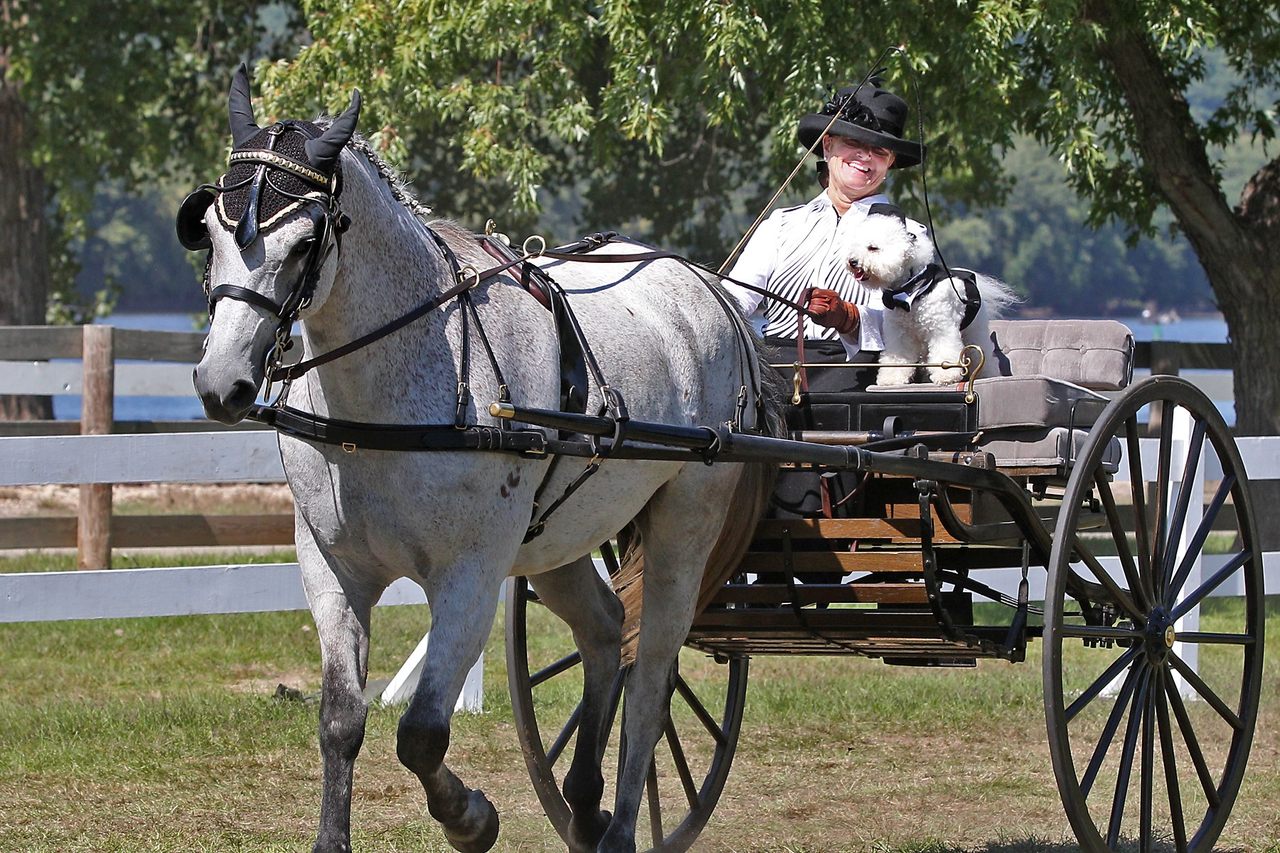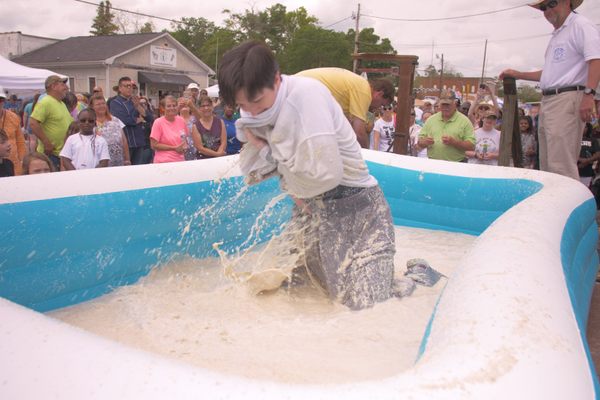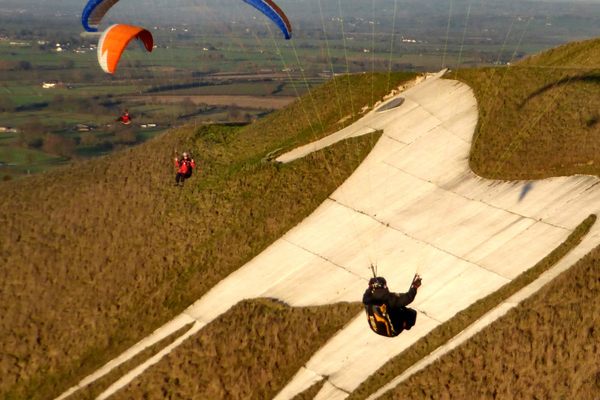Could This Be the Most Midwestern Competition of All?
Just when you thought Wisconsin couldn’t get any more quaint.
A dog is sitting in a vintage carriage being pulled by a horse across a field in Wisconsin. The dalmatian is sitting next to its owner, Susan Keating, who maintains her hold on the brown reins. Keating is a multiple-title winner in the world of competitive carriage racing, and God willing, her dog will be too. The dalmatian has a single job: sit next to her and be well-behaved. In this competition, the pair will be judged, essentially, on how good the dog is. And if you know dogs, you know that job is not always the easiest for them.
The ride goes smoothly until about the halfway point of the arena. Some ducks, probably spooked by the amount of people and horses around, start running around the yard inside the track. Keating’s dalmatian shifts in its seat, eying the ducks. And then in a sudden burst, the dog shoots out of the carriage, chasing after the ducks. It’s game over for Keating.
Keating and her dalmatian are competing in the Carriage Dog class of the Villa Louis Carriage Classic in Prairie du Chien, Wisconsin. It’s one of the largest carriage driving competitions in the whole carriage classic circuit, and one of the most coveted titles. More than 125 competitors drive in on the Friday after Labor Day with their horses and carriages in tow for a full three days of friendly sport.

Though the idea of a carriage-driving competition may conjure up images of riders whipping horses from a two-wheeled chariot as they fly around a racetrack at breakneck speed, the Carriage Classic—and all the other pleasure driving competitions—is nothing like that. It’s a gentle pace, focused on horsemanship, carriage qualities, and curious moments when dogs ride in carriages pulled by horses.
That’s not to say that intense carriage driving competition doesn’t exist, though. It’s just another branch of the sport, called Combined Driving Events (CDE).
“A lot of the CDE people think that traditional carriage driving, where you’re just going around a ring with other competitors at the same time, is a little dull,” says Hannah Polson, a competitor, groom, and organizer of the Lorenzo Driving Competition in New York. “They’re used to galloping around a course and making lots of sharp turns and different obstacles. Traditional carriage driving people sometimes think that the CDE people are a little too gutsy and too aggressive. For lack of a better phrase, it’s too much like NASCAR.”
Both evolved out of Victorian-era carriage driving, when people dressed up in their best clothes to head out with their horse and carriage. Villa Louis organizer Mike Rider says that competitions exist partly because the horse and carriage community was worried the skills needed to drive a carriage were going to fade. But it’s also a way to hold on to tradition.

“It’s a skill that very few people have,” Rider says. “Horses built this country. The factories that built automobiles were built by horses. Horses were the reason that the industrial revolution happened. They were the key to what made us what we are now. So I think that the important part is recognizing the link to good horses and horsemanship.”
The competition at Villa Louis heads into its 43rd year in 2024, carrying on these traditions with a little bit of extra quirk. Over three days, competitors try to win ribbons (and no monetary prize) for both main arena events and obstacle events.
The obstacle events are a bit tricky. In the Cross Country contest, participants drive their carriages through a simulation of a countryside drive, complete with laundry lines, water crossings, bridges, and wooded trails. For the Timed Obstacle contest, drivers must navigate through cones without knocking off balls that are balanced on top. With the Gambler’s Choice course, drivers negotiate obstacles that can change from year to year—like stopping at a bartender to get a drink or driving through hanging strips of cloth. There’s also the Reverse Psychology course, where drivers go through all the obstacles, and then turn around and go through them backwards.
The main arena events are more traditional. They include seven classes: Reinsmanship, based on driver performance; Turnout, based on how the driver, horse, carriage, and tack look; Working, based on horse performance; Drive and Ride, where you switch from driving to riding; Attendants, where the grooms get to show off their skills; Concours d’Elegance, where elegance is the main draw. Then there’s the Carriage Dog class and another charming event called the Picnic class.

For the Picnic class, competitors do turnouts in the arena and then set up a picnic that’s judged on theme and food. Costumes are encouraged. One year, Polson says, a competitor picked a bee theme. The driver was a beekeeper, the carriage was a hive, and the horse was a bee, complete with wings. Rider says that this year at Villa Louis, one of the competitors held a German picnic, with appropriate outfits, schnitzel, and potato salad.
Jordan Oehlhof is a 15-year-old carriage driver who, as a novice competitor, can’t participate in everything. But she has quite the fireball to deal with on show day, as she gears up for events like Turnouts and the Working class. Her horse, Dallas, is a three-quarter Dutch harness and one-quarter saddle-bred, and today he is anxious. It’s up to Oehlhof to calm him down before the big show—even though she’s just as nervous.
“It can cost you your ribbon or knock you down a spot for placing,” Oehlhof says about Dallas’ pre-show anxiety. “Working through that is one of the hardest things. It can be frustrating, but I can’t get angry at him, because it’s not his fault.”

Luckily, Oehlhof knows a thing or two about calming horses. She’s trained for this carriage competition with her grandfather, who’s been competing for about 30 years. After a few comforting words, Dallas pulls Oehlhof into the ring for the Concours d’Elegance Class, under the watchful eye of the judges and the rows of spectators scattered along the edges of the course.
Once Dallas and Oehlhof enter the arena, all traces of anxiety disappear. The duo heads around the ring, Oehlhof sitting stick straight in the carriage and Dallas at a light trot. It’s an emotional moment for her.
“It makes me feel proud because putting in every-day work pays off,” she says. “It’s cool to see how all that hard work can turn into something beautiful.”
Oehlhof and Dallas nail it, bringing home the first place ribbon to wrap up a week of competition, elaborate costumes, and the occasional doggy carriage driver.














Follow us on Twitter to get the latest on the world's hidden wonders.
Like us on Facebook to get the latest on the world's hidden wonders.
Follow us on Twitter Like us on Facebook